5 melhores plataformas de integração 2024
January 8, 2024
O ritmo acelerado da inovação em tecnologia de integração continua inabalável. Há apenas alguns anos, as empresas estavam comprometidas com produtos complexos e locais que exigiam um investimento significativo (e contínuo) de tempo, recursos e orçamento.
Hoje, a integração empresarial é um facilitador da inovação, ajudando as organizações a se transformarem digitalmente e, ao mesmo tempo, acelerando avanços tecnológicos críticos.
Não mais casadas com a tecnologia local legada, as empresas estão migrando rapidamente para a nuvem. A infraestrutura modular de TI oferece maior agilidade e velocidade, garantindo negócios lucrativos e de sucesso duradouro.
Este guia do comprador atualizado fornece uma visão geral detalhada das plataformas de integração para que você possa comparar fornecedores com base nestas considerações importantes:
- Facilidade de implementação
- Preço
- Escalabilidade
- Segurança
- Compliance
O que é uma plataforma de integração?
A integração da plataforma conecta aplicativos de software independentes para agilizar as interações entre cada aplicativo.
Existem muitos tipos diferentes de tecnologia de integração disponíveis hoje, incluindo:
- IPaaS: Um conjunto de serviços em nuvem que permite o desenvolvimento, a execução e a governança de fluxos de integração conectando qualquer combinação de processos, serviços, aplicativos e dados locais e baseados em nuvem, dentro de uma organização individual ou em diversas organizações.
- Barramento de serviço corporativo (ESB): uma arquitetura que oferece suporte a componentes centralizados que realizam integrações de aplicativos.
- Plataformas de gerenciamento de API: Conectar dois ou mais aplicativos usando suas interfaces de programação de aplicativos (APIs) para trocar dados.
Com a mudança para operações baseadas em nuvem, a tecnologia iPaaS está liderando a tendência.
“O iPaaS passou para uma adoção generalizada em todo o mundo, atingindo de 20% a 50% do público-alvo global que usará as ofertas do iPaaS para integrar não apenas aplicativos e dados, mas também ecossistemas, APIs e processos de negócios.”
Ciclo de hype do Gartner para serviços de plataforma em nuvem 2022
As cinco principais ferramentas de integração empresarial
A plataforma de integração Digibee
CARACTERÍSTICAS PRINCIPAIS
- Plataforma nascida na nuvem: crie facilmente integrações com recursos reutilizáveis pipelines e cápsulas
- Interface low-code: Não é necessário treinamento especializado, todos os desenvolvedores familiarizados com JSON se sentirão confortáveis com o Digibee
- Alertas automatizados: Monitoramento preventivo de erros para resolução imediata
- Configurações globais: Gerencie contas, chaves de API e várias instâncias em um único painel com botões liga/desliga para configurações comuns
- Painel de execução Digibee: Teste integrações com segurança e aplique parâmetros globais, implemente em segundos
- Painel único em tempo real: Monitore e solucione problemas de integração pipelines em vários projetos, visualize métricas de desempenho rapidamente, classifique erros e automatize mecanismos de resposta, use conectores pré-construídos para enviar dados para sistemas de emissão de tíquetes, como o JIRA
- Saiba Mais
DEPOIMENTOS
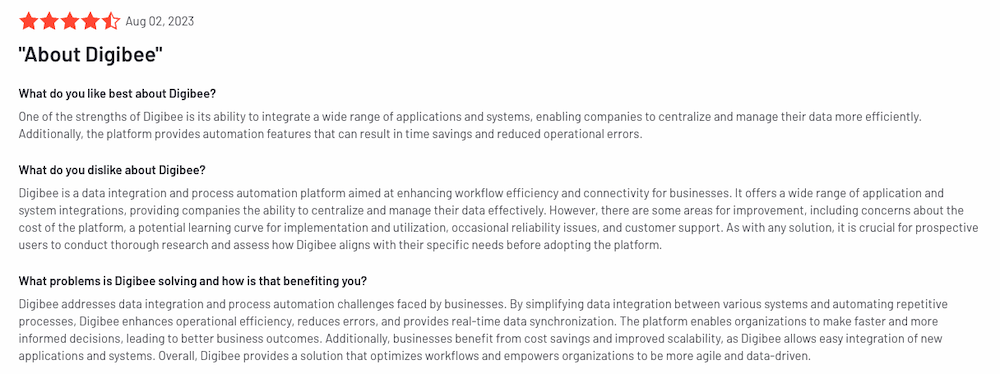


| PRÓS | CONTRAS |
|---|---|
| – Plataforma autenticamente nascida na nuvem – Implementar em semanas versus meses (ou anos) – Trabalha em conjunto com soluções iPaaS legadas existentes para acelerar iniciativas de inovação estagnadas – Acessível a desenvolvedores de todos os níveis de habilidade, sem necessidade de treinamento ou certificação dispendiosa – Modelo de preços simples e completo que inclui manutenção e suporte | – Embora ganhe rapidamente participação de mercado, a Digibee é nova no mercado – A tecnologia se concentra exclusivamente na integração versus recursos mais amplos, como gerenciamento de API |
CLIENTES
- Irmãos Johnson (distribuidor de bebidas)
- Lowes (empresa de varejo especializada em reformas residenciais)
- Payless (rede internacional de calçados com desconto)
- Histórias adicionais de clientes
Preços
Digibee preços reflete um modelo contemporâneo “tudo em um” que fornece acesso gratuito às mais recentes inovações e capacidades de produtos. O preço é incrivelmente simples, exigindo apenas três SKUs sem limitações. Em vez de cobrar pelo uso máximo potencial (modelo de preços típico para soluções iPaaS legadas), os clientes da Digibee pagam apenas pelo que consomem.
O modelo de precificação é baseado no fornecimento de pipelines e Unidades de tempo de execução (RTUs), como segue:
- Pipeline: Um caminho de integração que utiliza uma sequência de componentes para conectar sistemas e estabelecer fluxo de dados entre eles
- UTRs: Unidades de tempo de execução que suportam requisitos de capacidade baseados em transações simultâneas e/ou memória
SKU #1
Pacote de primeiros passos
10 pipelines, 20 UTRs de produção, 10 UTRs de teste
SKU #2
Adicional Pipeline
Adicional pipeline, inclui UTRs de produção/teste
SKU #3
Capacidade Adicional
Mais RTUs conforme necessário em ambientes de produção/teste
À medida que a estratégia de integração do cliente se expande, pipelines e RTUs são adicionadas conforme necessário. Isso garante que o cliente pague apenas pelo que usa, com o preço por unidade diminuindo conforme a implementação cresce.
Os clientes da Digibee acessam todos os recursos e capacidades sem nenhum custo extra. Um novo cliente pode começar com o SKU nº 1 por menos de US$ 60,000, incluindo:
- iPaaS hospedado pela Digibee
- Todo suporte e manutenção, 24 horas por dia, 7 dias por semana, 365 dias por ano, incluindo todos os novos recursos e atualizações
- Educação continuada
- Capacitação do cliente com suporte direto da Digibee para projetar, construir, testar e executar integrações
Digibee fornece um tour interativo do produto da Plataforma de Integração.
AVALIAÇÃO
- Classificação G2 = 4.7 de 5
MuleSoft: plataforma Anypoint para integração
CARACTERÍSTICAS PRINCIPAIS
- Designer de API Anypoint: Biblioteca de APIs, modelos, exemplos e conectores
- Estúdio Anypoint: IDE para integração e desenvolvimento de API com módulos pré-construídos
- Conectores Anypoint: Use uma interface web ou um IDE de desktop para integrar sistemas)
- Troca a qualquer momento: Marketplace para conectores, modelos, exemplos e APIs)
- Anypoint DataGraph: Reutilize, consuma e unifique várias APIs
- Gerente de parceiros Anypoint: Acelere a integração de parceiros e simplifique o gerenciamento de parceiros
- Qualquer ponto MQ: Serviço de mensagens para padrões de comunicação assíncrona
- Construtor de código Anypoint: IDE para projetar, desenvolver, implantar APIs, integrações e automações
DEPOIMENTOS



| PRÓS | CONS |
|---|---|
| – Veterana do setor legado, a MuleSoft possui uma forte lista de clientes estabelecidos que investiram pesadamente na tecnologia – O conjunto de recursos da Mulesoft é profundo, indo muito além dos recursos iPaaS | – Modelo de preços complicado e caro – Todos os desenvolvedores e arquitetos de software devem ser certificados pela MuleSoft para usar a tecnologia e interagir com o suporte ao cliente em qualquer assunto – Os ciclos de fim de vida são crônicos e demorados, monopolizando recursos caros dos desenvolvedores |
CLIENTES
Como fornecedor de tecnologia legada, a base de clientes da MuleSoft é ampla e variada. Os clientes apresentados no site da empresa incluem:
- Airbus
- Barclays
- Citrix
Preços
Os preços da MuleSoft são complicados, incorporando dois modelos de preços diferentes: baseados no uso e em níveis. Os clientes devem pagar por:
- VCore (para oferecer suporte ao uso do produto)
- Edição (ouro, platina, titânio)
- Gerenciamento de API (com base no uso e volume)
- Integração (três níveis diferentes)
- API Experience Hub (para recursos completos de gerenciamento de API)
- Recursos e complementos adicionais são opcionais
MuleSoft oferece uma avaliação gratuita de sua plataforma Anypoint.
AVALIAÇÃO
- Classificação G2 = 4.5 de 5
- Classificação Capterra = 4.4 de 5
Para um mergulho profundo no iPaaS legado da MuleSoft, leia o artigo de pesquisa.
Serviços de Integração do Azure
CARACTERÍSTICAS PRINCIPAIS
- Aplicativos lógicos: Crie workflows e orquestrar processos de negócios para conectar centenas de serviços na nuvem e no local
- Ônibus de serviço: Conecte-se a aplicativos e serviços locais e baseados em nuvem para implementar mensagens altamente seguras workflows
- Gerenciamento de APIs: Publique APIs com segurança para desenvolvedores internos e externos usarem ao se conectarem a sistemas back-end hospedados em qualquer lugar
- Grade de eventos: Conecte serviços suportados do Azure e de terceiros usando um serviço de roteamento de eventos totalmente gerenciado com um modelo de publicação-assinatura que simplifica o desenvolvimento de aplicativos baseados em eventos
- Funções do Azure: Simplifique problemas complexos de orquestração com uma solução orientada a eventos
- Fábrica de dados do Azure: Integre visualmente fontes de dados para construir processos ETL e ELT e acelerar a transformação de dados
REVISÃOWS


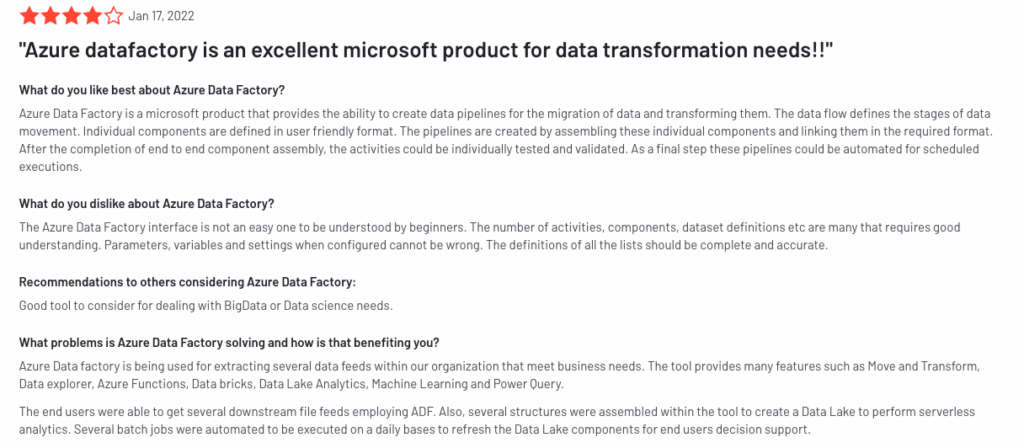
| PRÓS | CONTRAS |
|---|---|
| – Os desenvolvedores que trabalham em um ambiente existente do Azure são leais e podem preferir construir e codificar com ferramentas do Azure – Fortes ferramentas de gerenciamento de API – Uma grande base de clientes existente da Microsoft fornece uma base estável sobre a qual o Azure pode construir | – Ferramentas simples, incapazes de suportar casos de utilização empresariais sofisticados, com conectores pré-construídos limitados para além do ecossistema Azure, difíceis com ligações não lideradas por API – Cada ferramenta possui sua própria interface para aprender e gerenciar; uma curva de aprendizado profunda para todos os usuários – Numerosos e complexos modelos de preços dificultam o monitoramento e controle de custos |
CLIENTES
A grande base de clientes existente da Microsoft apresenta oportunidades adicionais significativas para os Serviços de Integração do Azure. Os clientes apresentados no site da empresa incluem:
- Re Suíça
- busca
- Fornecimento de linho missionário
Preços
O preço dos Serviços de Integração do Azure é variável. Durante a implementação, são necessários serviços de nuvem do Azure. Os custos adicionais dependem do número de serviços pagos implantados. Os custos contínuos incluem serviços adicionais de nuvem do Azure.
Os Serviços de Integração do Azure oferecem uma avaliação gratuita ou uma conta pré-paga para testar o produto.
AVALIAÇÃO
- Classificação G2 = 4.4 de 5
- Classificação Capterra = 4.6 de 5
estrondoso
CARACTERÍSTICAS PRINCIPAIS
- Inteligência: Recursos de IA incorporados para construir com mais rapidez e gerenciar com mais facilidade
- Composibilidade: Blocos de construção reutilizáveis e automatização poderosa
- Democratização: UX para todas as funções e habilidades, apoiando o controle de acesso baseado em funções e o desenvolvimento baseado em equipe
- Escala: Dimensione de forma elástica conforme necessário para lidar com cargas de trabalho variadas
- Segurança: Construído com segurança e confiabilidade de nível empresarial
- Gerenciamento do ciclo de vida: Controles integrados de controle de versão e governança de integrações, workflows, APIs e modelos de dados
DEPOIMENTOS
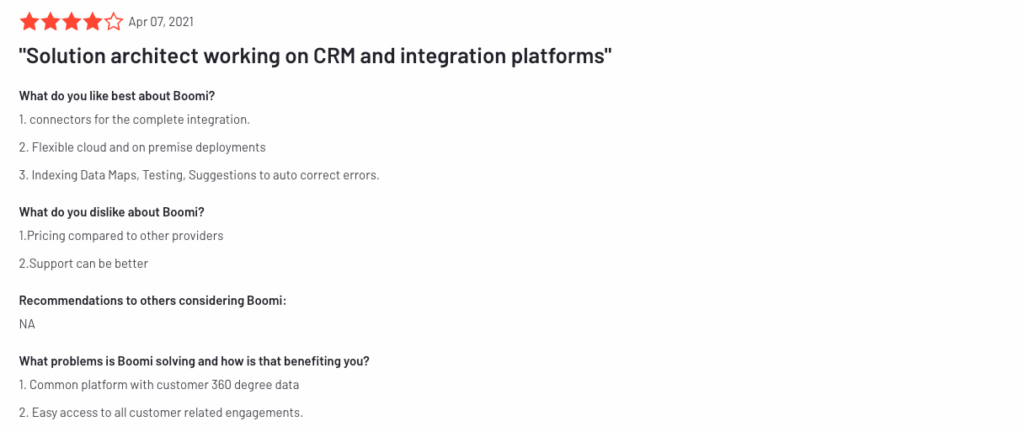
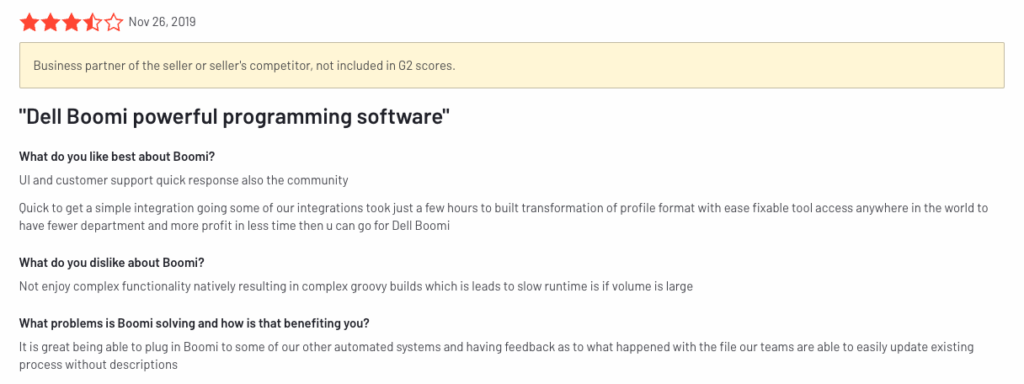
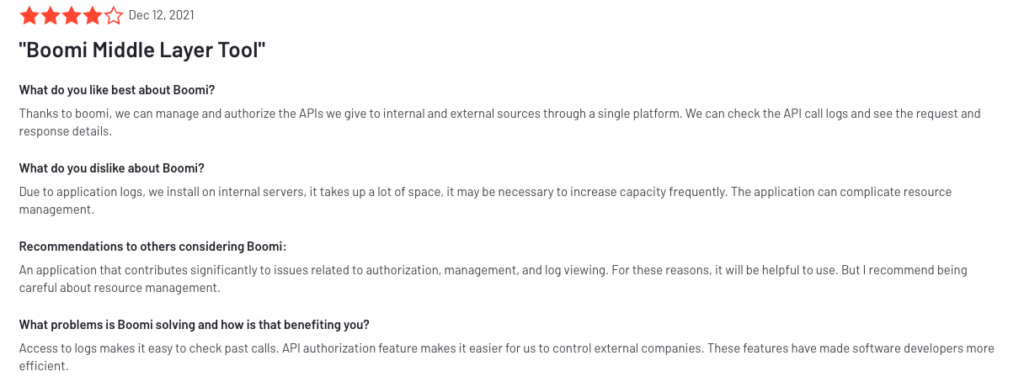
| PRÓS | CONTRAS |
|---|---|
| – Bem estabelecido no setor com uma grande base de clientes – Forte suporte para negócios remotos com infraestrutura que requer conectividade totalmente local – Uma escolha viável para organizações que preferem terceirizar a integração e, em vez disso, confiar nas conexões pré-construídas do Boomi, na rede de SIs e ISVs e no mercado Boomi | – Complexidade de uso com sete produtos pontuais diferentes – Caro, com preços e licenciamento complicados, cada ferramenta tem seu próprio modelo de preços baseado em volume, todo o suporte é pago – Roteiro de produtos voltado para desenvolvedores cidadãos e automação |
CLIENTES
- Cruz Vermelha Austrália
- Pizza MOD
- Boise State University
Preços
Os preços do Boomi incorporam uma combinação de preços escalonados e baseados em volume. As versões incluem Professional, Pro Plus, Enterprise e Enterprise Plus com recursos que variam de acordo com a versão.
Os clientes devem pagar por:
- Integração (recursos e números de conectores)
- Master Data Hub (aumenta o volume de dados)
- Gestão B2B/EDI (número de parceiros comerciais conectados)
- Gerenciamento de API (número de chamadas de API feitas)
- Fluxo (número de aplicativos criados)
- Catálogo e preparação de dados (número de conectores e usuários)
AVALIAÇÃO
- Classificação G2 = 4.2 de 5
- Classificação Capterra = 4.5 de 5
Workato
CARACTERÍSTICAS PRINCIPAIS
- Projeto de receita: Personalize receitas com diferentes gatilhos, ações e outras etapas
- conectores: Inclui um método de autenticação, gatilhos e ações para um aplicativo específico
- Conectividade local: Uma conexão segura de dentro de um ambiente de TI privado para conectar-se à nuvem Workato
- Plataforma API: Transforme receitas de API em endpoints para que outras pessoas possam consumir dados facilmente sem acesso a uma conta específica do Workato
- Robô de trabalho: Construa personalizável workflows
REVISÃOWS
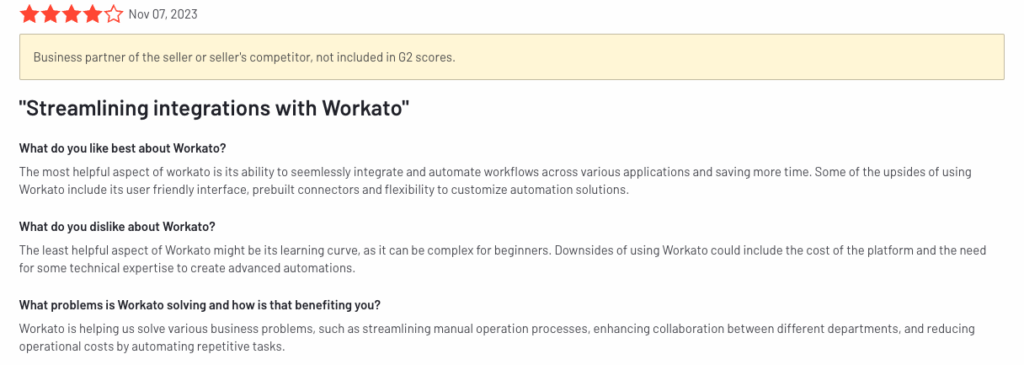


| PRÓS | CONTRAS |
|---|---|
| – Conhecido pela facilidade de uso na automação predial em linhas de uso de negócios menos sofisticadas que se concentram em desenvolvedores cidadãos – A maioria dos negócios está incorporada a ISVs para apoiar a expansão – Especialmente popular entre pequenas e médias empresas | – Dificuldade em executar integrações empresariais sofisticadas – Reputação de aceleração de preços uma vez implantado (cobranças por tarefas e conectores) – Incapaz de implantar em uma nuvem privada, deve hospedar tudo |
CLIENTES
Os clientes apresentados no site da empresa incluem:
- Broadcom
- Atlassian
- MGM
Preços
Os preços do Workato variam de acordo com as integrações para o negócio ou produto:
- Workato para Empresas: comece com um espaço de trabalho, incluindo aplicativos, conexões e usuários ilimitados. Receitas adicionadas individualmente ou em pacotes (10, 25, 50, 100)
- Workato para Produtos: Integrações e workflow automações construídas para produtos. Conecte-se a milhares de aplicativos com suporte 24 horas por dia, 7 dias por semana
As opções incluem:
- Nuvem ou local, assinatura
- Aplicativos locais, bancos de dados, aplicativos personalizados (conectados com REST, SOAP)
- Os complementos opcionais incluem segurança, operações e muito mais (para empresas)
AVALIAÇÃO
- Classificação G2 = 4.7 de 5
- Classificação Capterra = 4.6 de 5
O que procurar em uma plataforma de integração
Claramente, as plataformas tecnológicas de integração variam de acordo com o conjunto de recursos, modelos de preços e outros diferenciais. Ao construir sua estratégia de integração empresarial, considere estes benefícios universais:
Compatibilidade
O software da sua plataforma de integração deve ser compatível com os sistemas e aplicativos que você usa hoje, bem como com as inovações que você implementará no futuro.
Sistemas iPaaS nascidos na nuvem, como o Digibee, oferecem suporte nativo a uma infraestrutura de TI combinável. Esse ambiente ágil facilita a conexão de todos os sistemas e aplicativos – legados ou novos de última geração – independentemente de serem legados, locais ou já estarem na nuvem.
Facilidade de uso
A tecnologia complicada que exige treinamento significativo e certificação cara limita os recursos disponíveis para realizar o trabalho. Também resulta em tempos de implementação muito longos para uma entrada no mercado prolongada.
Com um dos tempos de implementação mais rápidos do mercado, o Digibee é 70% mais rápido que as soluções de integração legadas. Assista ao vídeo para ver a rapidez com que os desenvolvedores criam integrações com o Digibee.
Preço
Para a maioria das empresas, investir na integração de plataformas é uma proposta cara. De acordo com pesquisa State of Enterprise Integration da Digibee em 2023, 59% dos entrevistados investiram até um quarto do seu orçamento de TI em integração.
Evite modelos de preços complexos, especialmente comuns em soluções legadas que tendem a combinar o uso com base em preços escalonados – um modelo que é difícil de monitorar e controlar. Melhores práticas do Gartner ao avaliar preços de iPaaS é um recurso útil.
Manutenção e suporte
Muitas vezes esquecidos durante as negociações são os custos contínuos relacionados à manutenção e suporte.
As soluções modernas de integração nascidas na nuvem são atualizadas perfeitamente, garantindo que todos os usuários tenham acesso aos recursos e capacidades mais recentes sem investir recursos (e possível tempo de inatividade) para oferecer suporte a uma nova versão de software.
A tecnologia iPaaS contemporânea diminui a dependência de um fornecedor para suporte. Isto se reflete em Oferta de suporte da Digibee que é fornecido gratuitamente. Com uma interface intuitiva e recursos de arrastar e soltar, os desenvolvedores aprendem e trabalham rapidamente por conta própria para obter resultados rápidos.
Experimente antes de comprar
Cada fornecedor apresentado neste guia do comprador oferece uma demonstração e/ou avaliação para que você possa testar a tecnologia antes de se comprometer. Muitos clientes da Digibee começaram sua jornada com um passeio guiado e interativo, fazendo a transição para um Demonstração personalizada de 60 minutos projetados para abordar seus casos de uso específicos em seu ambiente existente.
Use estes recursos para ajudar a informar sua estratégia de integração empresarial:
- A Relatório sobre o estado da integração empresarial 2023 para obter insights sobre como seus colegas estão aproveitando a tecnologia
- A Página de preços Digibee abrange nosso modelo de preços simples com comparações úteis sobre assinaturas e serviços
Para mais informações, dê uma olhada em nosso site do produto or entre em contato conosco para conversar com nossa equipe. Boa sorte com seu projeto de integração!
[1] Glossário Gartner: Plataforma de Integração como Serviço (iPaaS)




